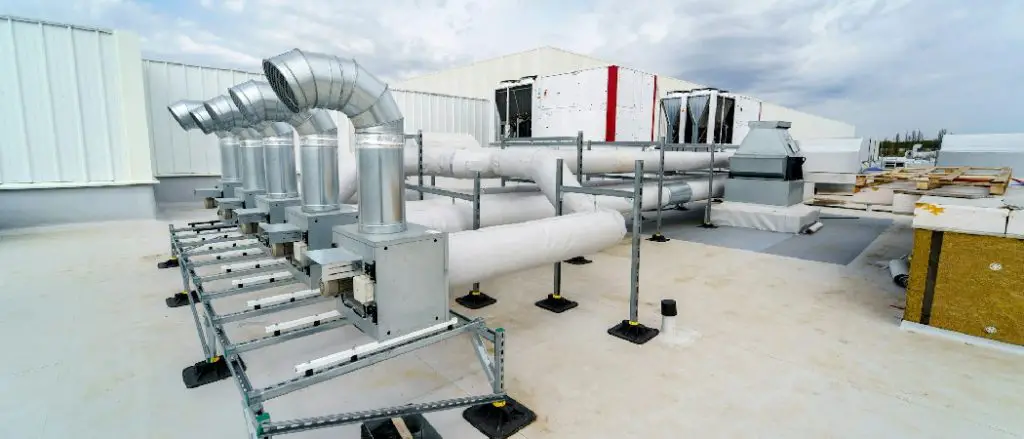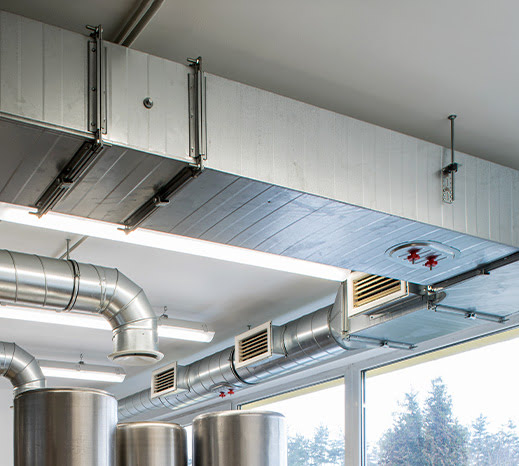To eliminate ductwork noise, check for loose connections and secure them tightly. Install acoustic insulation around ductwork to dampen sound vibrations.
Ductwork noise can be a nuisance in homes and buildings, disrupting peace and quiet. By following a few simple steps, you can effectively reduce or eliminate this unwanted noise. Loose connections in ductwork can often be a common source of noise, so ensure all connections are securely fastened.
Adding acoustic insulation around the ductwork can also help dampen sound vibrations and minimize noise transmission. With these practical solutions, you can create a more peaceful and comfortable indoor environment free from the distractions of ductwork noise.

Understanding Ductwork Noise
Causes Of Ductwork Noise
If you’ve ever experienced the annoying humming or rattling sounds coming from your ductwork, you know how disruptive it can be to your peace and quiet. But what exactly causes this ductwork noise? Let’s explore the most common reasons behind it.
1. Poor Duct Installation: Improper installation of ductwork can result in loose connections or gaps, causing air to leak and create turbulence, which in turn generates noise.
2. Ductwork Material: The type of material used for your ductwork can contribute to noise issues. Thin metal ducts, for example, tend to vibrate more, leading to noise transmission.
3. Inadequate Duct Insulation: Insulation helps reduce noise transmission, and ductwork without proper insulation can allow sounds to travel more easily throughout your home.
4. Restrictive Duct Design: A poorly designed duct system with bends, sharp turns, or excessive length can create air turbulence and noise as the airflow gets disrupted.
Impact Of Ductwork Noise On Comfort
The impact of ductwork noise goes beyond just being a nuisance. It can also affect your overall comfort and well-being. Let’s take a closer look at its potential consequences:
1. Sleep Disruption: If your bedroom is near the ductwork, the noise can interfere with your sleep, leading to fatigue and decreased productivity.
2. Reduced Concentration: Constant background noise from your ducts can make it difficult to focus, stay alert, and perform daily tasks efficiently.
3. Stress and Anxiety: Long-term exposure to unwanted noise can increase stress levels and contribute to feelings of anxiety, impacting your mental health.
4. Decreased Energy Efficiency: Noisy ducts often accompany airflow issues, such as leaks or restrictions, which can compromise the efficiency of your HVAC system and increase energy bills.
Now that we understand the root causes and the potential impact of ductwork noise, it’s essential to explore effective solutions to eliminate this nuisance and restore peace and comfort in your home.

Assessing The Noise
Start of HTML code
H2 Heading for Assessing the Noise
Identifying problem areas:
Strong tag for bold text
Inspect ductwork for loose connections, vibrations, or obstructions.
Check for gaps or leaks that could cause noise disturbances.
Measuring Noise Levels
H3 Heading Measuring noise levels
-
Unordered list for clarity
- Use a decibel meter to quantify sound levels in various locations.
- Record measurements near vents, corners, and bends in the ductwork.
- Compare noise levels at different times to determine patterns.
End of Unordered List
Ensure each H3 heading adheres to HTML syntax.
Strong tag for bold text
Eliminating Noise From Ductwork
Noise from ductwork can be a frustrating and persistent problem in many homes. Fortunately, there are several effective ways to eliminate this annoyance and restore peace and quiet to your living space. From inspecting and repairing ducts to using noise reduction materials, these solutions can make a significant difference in reducing the impact of ductwork noise.
Inspecting And Repairing Ducts
Inspecting the ductwork for any leaks or damaged sections is an essential first step. Sealing these issues can significantly reduce noise transmission. Repairs should target loose connections, kinks, or any other structural problems that could be contributing to the noise.
Using Noise Reduction Materials
Applying noise reduction materials, such as acoustic duct liners or dampening foils, can help to dampen the noise traveling through the ducts. These materials absorb sound waves, resulting in a quieter and more comfortable environment.
Adding Insulation
Enhancing insulation around the ductwork can also minimize noise. Thick insulation materials can help to muffle the sound and reduce its transmission, contributing to a quieter living space.
Upgrading To Insulated Ducts
Investing in insulated ducts can be a worthwhile solution to eliminate noise. These ducts are designed with built-in insulation, providing a superior barrier against sound transmission and offering improved noise reduction compared to traditional ductwork.
Addressing Airflow Issues
Balancing the airflow within the system and ensuring proper HVAC maintenance can also contribute to reducing ductwork noise. Optimizing the airflow can minimize turbulence within the ducts, thus reducing the potential for noise generation.

Maintaining A Silent Duct System
Keeping your duct system running smoothly and quietly involves regular cleaning, sealing air leaks, and balancing airflow. These simple steps can significantly reduce ductwork noise and ensure a more peaceful indoor environment.
Regular Cleaning And Maintenance
Regular cleaning and maintenance of ductwork are crucial to eliminate noise caused by debris and dust buildup. Create a schedule for professional inspection and cleaning of the duct system at least once a year.
Sealing Air Leaks
Sealing air leaks is essential to prevent excess noise in the duct system. Check all connections and joints for any gaps or leaks, and use appropriate sealing materials to ensure a tight seal. This can significantly reduce air escape and subsequent noise.
Balancing Airflow
Balancing airflow throughout the duct system can address uneven pressure, which often leads to noisy air movement. Ensure that each room receives proper airflow by adjusting dampers and registers as needed, resulting in a quieter, more efficient system.
Quieting Ductwork Vibration
Is your peaceful home ambiance disrupted by loud ductwork noise? Quieting ductwork vibration can be the key to restoring tranquility to your living space. Identifying and dampening vibration sources, as well as installing vibration isolation devices, are essential steps in the process.
Identifying And Dampening Vibration Sources
Before taking any corrective measures, it’s crucial to identify the sources of vibration in your ductwork. Common sources of vibration include unsecured duct sections, loose hangers, and unbalanced HVAC equipment. Inspect the ductwork visually and physically to locate any irregularities causing vibrations.
- Tighten loose hangers and supports to stabilize the ductwork
- Ensure all duct sections are properly secured and fastened
- Balance HVAC equipment to minimize vibrations
Installing Vibration Isolation Devices
Once the vibration sources are identified and dampened, consider installing vibration isolation devices to further reduce ductwork noise. These devices work by absorbing and dampening the vibrations, preventing them from transmitting to the surrounding structure.
Choose from a variety of vibration isolation devices, including isolation mounts, spring isolators, and flexible connectors. Selecting the appropriate isolation device depends on the specific nature of the vibration and the HVAC system’s requirements.
- Isolation mounts provide a buffer between the ductwork and the supporting structure
- Spring isolators absorb and dissipate vibrations within the system
- Flexible connectors create a flexible joint to minimize vibration transfer

Silencing Noisy Air Vents
Eliminate ductwork noise by silencing noisy air vents. Implement soundproofing materials and check for loose parts to reduce disruptive airflow sounds in your home. Increas air quality and improve overall comfort by addressing this common issue effectively.
Cleaning And Adjusting Vents
If you want to silence noisy air vents, the first step is to clean and adjust them properly. Over time, vents can accumulate dust, dirt, and debris, which can restrict airflow and cause annoying noises. Here are some steps you can follow:
- Carefully remove the vent cover by unscrewing or lifting it off.
- Use a vacuum cleaner with a brush attachment to gently clean the vent cover, removing any dust and debris.
- Inspect the inside of the ductwork and use the vacuum cleaner or a long-handled brush to clean out any accumulated dirt.
- Once cleaned, adjust the damper or airflow lever on the vent, if applicable, to ensure it is fully open or adjusted to your desired airflow.
- Replace the vent cover, making sure it fits securely and does not rattle or vibrate.
By regularly cleaning and adjusting your vents, you can help reduce the potential for noise caused by airflow restrictions, ensuring smooth and silent operation.
Installing Soundproof Vent Covers
Another effective way to silence noisy air vents is by installing soundproof vent covers. These covers are designed to minimize the noise generated by the airflow and vibrations within the ductwork. Here’s how you can do it:
- Measure the size of your existing vent cover to ensure you purchase the correct size soundproof cover.
- Remove the old vent cover and clean the area around the vent.
- Place the soundproof vent cover over the opening, ensuring it fits snugly.
- If necessary, secure the vent cover using screws or other provided fasteners.
The soundproof vent cover acts as a barrier, absorbing or blocking the noise generated by the airflow. By installing these covers, you can significantly reduce the noise levels from your air vents, creating a quieter and more peaceful living space.
Adopting Noise-reducing Hvac Equipment
Eliminate the annoying noise from your HVAC system by adopting noise-reducing equipment. Quiet ductwork ensures a peaceful environment without the common disturbances caused by HVAC systems. Improve your indoor experience without compromising on comfort and efficiency.
Choosing Quiet Hvac Units
When it comes to eliminating ductwork noise, one of the most effective steps you can take is choosing quiet HVAC units. Whether you’re installing a new system or replacing an existing one, opt for units specifically designed to reduce noise levels. This will ensure a more peaceful and comfortable environment in your home or office.
When choosing a quiet HVAC unit, consider the following factors:
1. Noise rating: Look for units with a low noise rating, measured in decibels (dB). The lower the decibel rating, the quieter the unit will be.
2. Vibration control: Units with built-in vibration control mechanisms help minimize noise caused by mechanical movements.
3. Variable speed fans: HVAC units with variable speed fans allow for more precise control over airflow, reducing the need for loud, high-speed operation.
4. Noise-reducing technologies: Some manufacturers incorporate advanced noise-reducing technologies, such as sound insulation, into their units. These features help dampen noise and ensure quieter operation.
Using Noise-absorbing Duct Fittings
In addition to choosing quiet HVAC units, another effective way to eliminate ductwork noise is by using noise-absorbing duct fittings. These fittings are designed to minimize vibrations and sound waves, resulting in a quieter overall system.
Here are some noise-absorbing duct fittings to consider:
1. Flexible duct connectors: These connectors are made of materials that absorb vibrations and reduce noise transmission between duct sections.
2. Duct liner insulation: Installing duct liner insulation helps to dampen noise by absorbing sound waves and reducing air turbulence within the ducts.
3. Air silencers: Air silencers, also known as air attenuators, are devices designed to reduce noise caused by high-velocity airflow. They can be installed at strategic points in the ductwork to minimize noise transmission.
4. Resilient channel mounts: Mounting ductwork on resilient channels helps isolate it from surrounding structures, reducing the transfer of noise and vibrations.
By adopting noise-reducing HVAC equipment and using noise-absorbing duct fittings, you can significantly reduce or even eliminate ductwork noise in your home or office. Remember to consider the noise rating, vibration control, variable speed fans, and noise-reducing technologies when choosing HVAC units. Additionally, incorporate flexible duct connectors, duct liner insulation, air silencers, and resilient channel mounts to further minimize noise transmission. Enjoy a more peaceful and quiet environment by implementing these noise-reducing measures.
Professional Solutions
Ductwork noise can be a significant disruption in households, but consulting with HVAC professionals can help address this issue effectively.
Consulting With Hvac Professionals
When experiencing ductwork noise, seek professional guidance from HVAC experts who can diagnose and rectify the source of the problem.
Soundproofing Options
By opting for soundproofing solutions, such as adding insulation or acoustic panels, you can effectively reduce ductwork noise in your space.
Frequently Asked Questions For How To Eliminate Ductwork Noise
How Can I Make My Ducts Quieter?
To make ducts quieter, you can take these steps: 1. Insulate the ducts to reduce noise transmission. 2. Install soundproofing materials such as acoustic duct liners or flexible duct connectors. 3. Use vibration isolation devices like rubber pads or hangers to reduce equipment noise.
4. Ensure proper duct sizing to minimize airflow noise. 5. Regularly clean and maintain the ducts to prevent obstructions and rattling noises.
Why Are My Air Ducts So Loud?
Loud air ducts may be caused by loose parts, blocked airflow, or improperly sized ducts. Regular maintenance can help reduce noise levels.
How Can I Reduce The Noise In My Hvac System?
To reduce noise in your HVAC system, try these steps: 1. Clean or replace air filters regularly to prevent blockage and airflow restriction. 2. Insulate ductwork to minimize vibration and sound transmission. 3. Add sound-absorbing materials like acoustic insulation or duct liners.
4. Check for loose or worn fan blades and tighten or replace as needed. 5. Schedule regular HVAC maintenance to identify and fix any noise-related issues.
How Do You Stop Sound From Traveling Through Air Ducts?
To stop sound from traveling through air ducts, insulate them with sound-absorbing materials specifically designed for this purpose. You can also install acoustic foam or soundproofing panels inside the ducts. Additionally, sealing any gaps or leaks in the ductwork can help prevent sound transmission.
Regular maintenance is crucial.
Conclusion
In a nutshell, addressing ductwork noise involves simple solutions like insulation and vibration dampeners. A quiet home leads to a peaceful environment and better quality of life. Implementing these tips can make a significant difference in reducing unwanted noise. Enjoy a serene and comfortable living space with these effective strategies.

